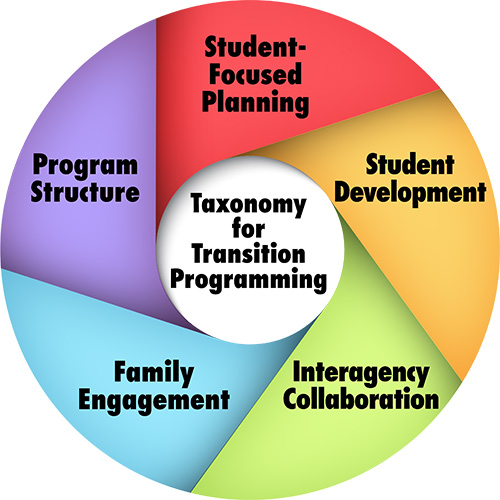Secondary Transition: Helping Students with Disabilities Plan for Postsecondary Settings
Wrap Up
 Due to a multitude of changes, secondary transition—the process of moving from high school to adulthood—can be a stressful time for students with disabilities and their families. To facilitate successful transitions and promote positive outcomes, the Individuals with Disabilities Education Act (IDEA) requires that students with disabilities receive tailored supports and services throughout the transition period.
Due to a multitude of changes, secondary transition—the process of moving from high school to adulthood—can be a stressful time for students with disabilities and their families. To facilitate successful transitions and promote positive outcomes, the Individuals with Disabilities Education Act (IDEA) requires that students with disabilities receive tailored supports and services throughout the transition period.
Developed and implemented through a process referred to as transition planning, or transition programming, these supports and services help students establish goals and develop the skills they will need in adulthood in three primary areas:
- Education and training
- Employment
- Community engagement and independent living if needed
As part of transition planning, the student’s IEP team develops a component of the IEP (sometimes referred to as the Individualized Transition Plan [ITP]) consisting of postsecondary goals, transition services to reach these goals, and annual goals aligned with the postsecondary goals. To help them effectively develop and implement this plan, the IEP team can use the Taxonomy for Transition Programming 2.0. This framework, which consists of five components, is outlined in the table below.
| Component | Action Steps |
|---|---|
| Student-Focused Planning |
|
| Student Development |
|
| Interagency Collaboration |
|
| Family Engagement |
|
| Program Structure |
|
Students should actively and meaningfully engage in each component of their transition planning. To do so, they will need self-determination, which educators can facilitate by providing many opportunities for students to make choices and take ownership over their own learning. In turn, students will develop and strengthen their ability to understand the supports that help eliminate or minimize barriers, self-advocate for those supports, and achieve their postsecondary goals.
In this interview, Valerie Mazzotti summarizes key points for implementing transition planning (time: 3:04).

Valerie L. Mazzotti, PhD
Roy A. Roberts Distinguished Professor of Special Education
Department of Special Education
University of Kansas
Transcript: Valerie L. Mazzotti, PhD
Number one, use your resources. NTACT:C, National Technical Assistance Center on Transition: The Collaborative, has a lot of free resources that are based on research that can support implementation of evidence-based and research-based practices and to really evaluate transition programs and practices to ensure that they align with research. Number two: build collaborative partnerships. Transition is really big, and having a team in place to support transition planning will be a win-win for students, families, schools, and communities. And a lot of times, building collaborative partnerships seems overwhelming, but use your resources. Talk to people in your community, talk to other school personnel, talk to your families, and talk to your students. Because doing that can open up a world of opportunity for students with disabilities and their families. Go and talk to employers in your community. While it can be an overwhelming process, it is extremely important that that support system is in place for students when they leave high school. Number three: evaluate your inclusive practices to ensure that all students with disabilities have a voice and opportunities to engage in all aspects of school and community. So really thinking about how can you get students with disabilities engaged so that they have opportunities similar to all students who have opportunities within the community, as that can only facilitate a positive experience both in school and post-school as students transition into adult life. Number four: use data-based decision making to ensure that the process of transition planning is individualized for all students. And that includes not just using data-based decision making and transition assessment with students, with families to identify students’ strengths, needs, preferences, and interests. It includes evaluating your transition programs and practices to ensure that they are effective and include research-based and evidence-based practices to support students as they transition into adult life. And I would say tip number five is thinking about transition planning across the continuum. Teachers in elementary school should be thinking about transition planning early. It looks different, but it’s critical that we start transition planning early because there’s a lot you can do early on related to self-determination and career awareness and inclusion in general education that could really potentially change trajectories for many of our students.
Revisiting Initial Thoughts
Think back to your response to the Initial Thoughts question at the beginning of this module. After working through the Perspectives & Resources, do you still agree with those responses? If not, what aspects about them would you change?
What is secondary transition, and why is it important for students with disabilities?
How can educators help support students in the transition planning process?
When you are ready, proceed to the Assessment section.